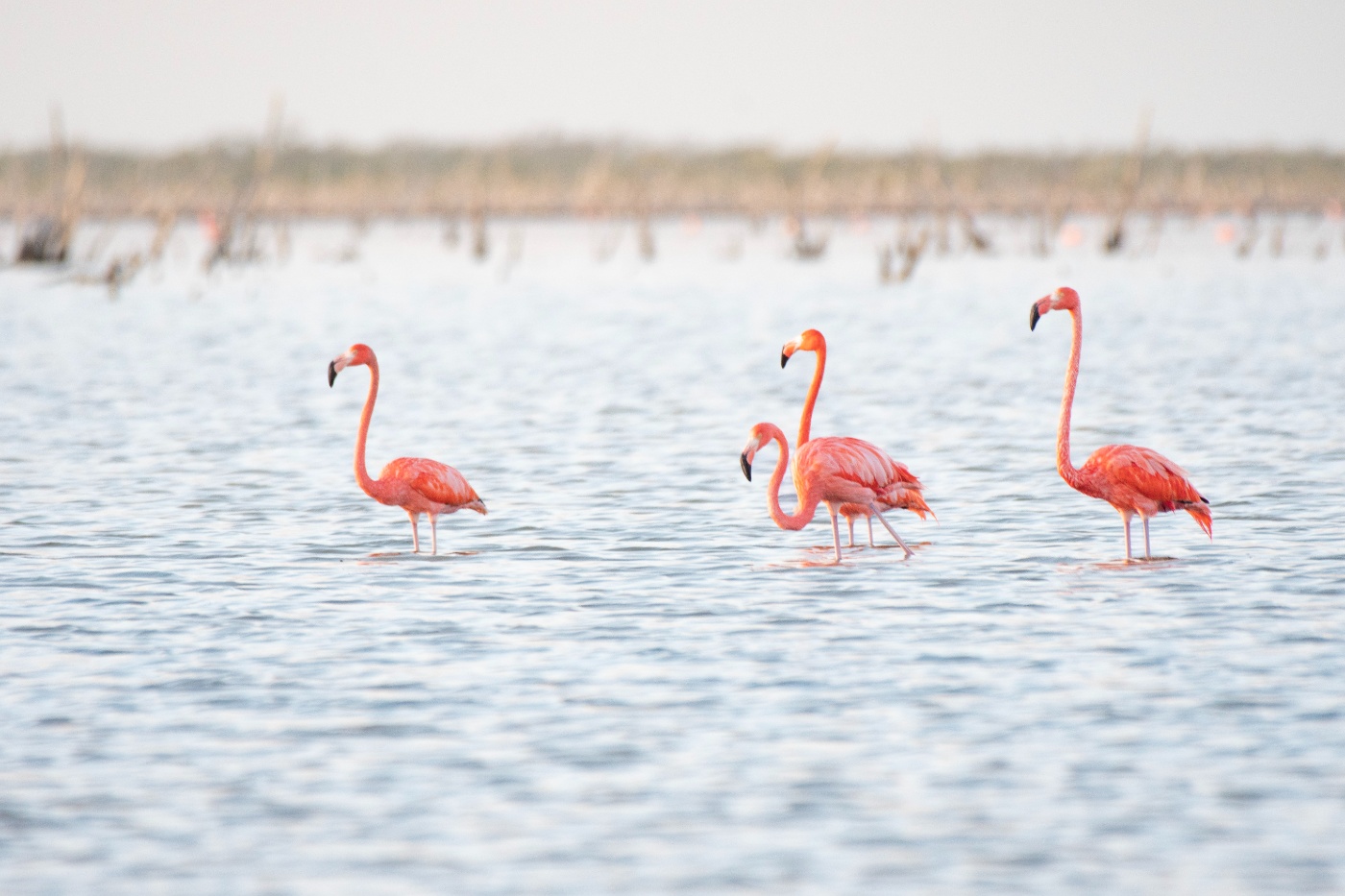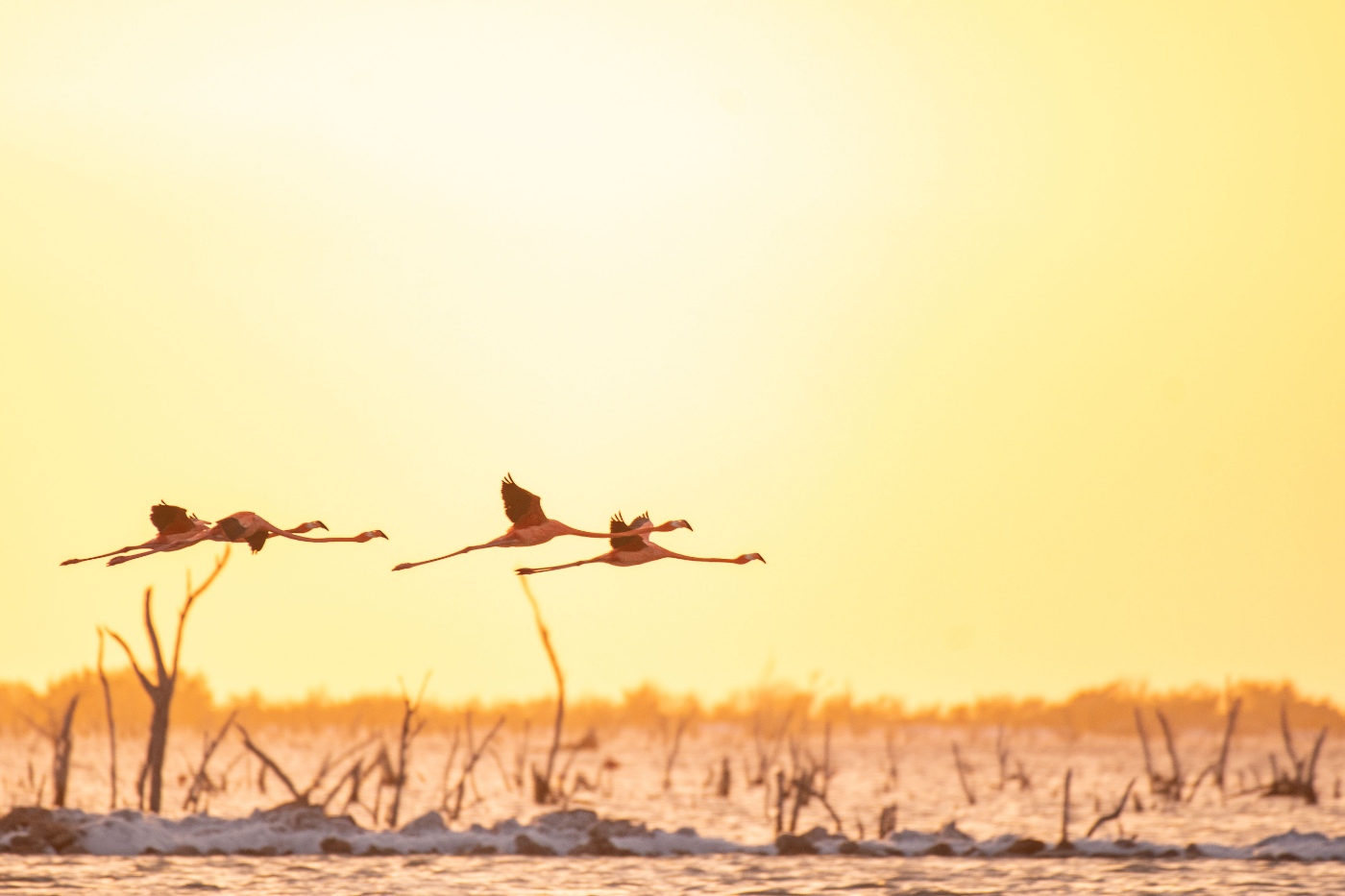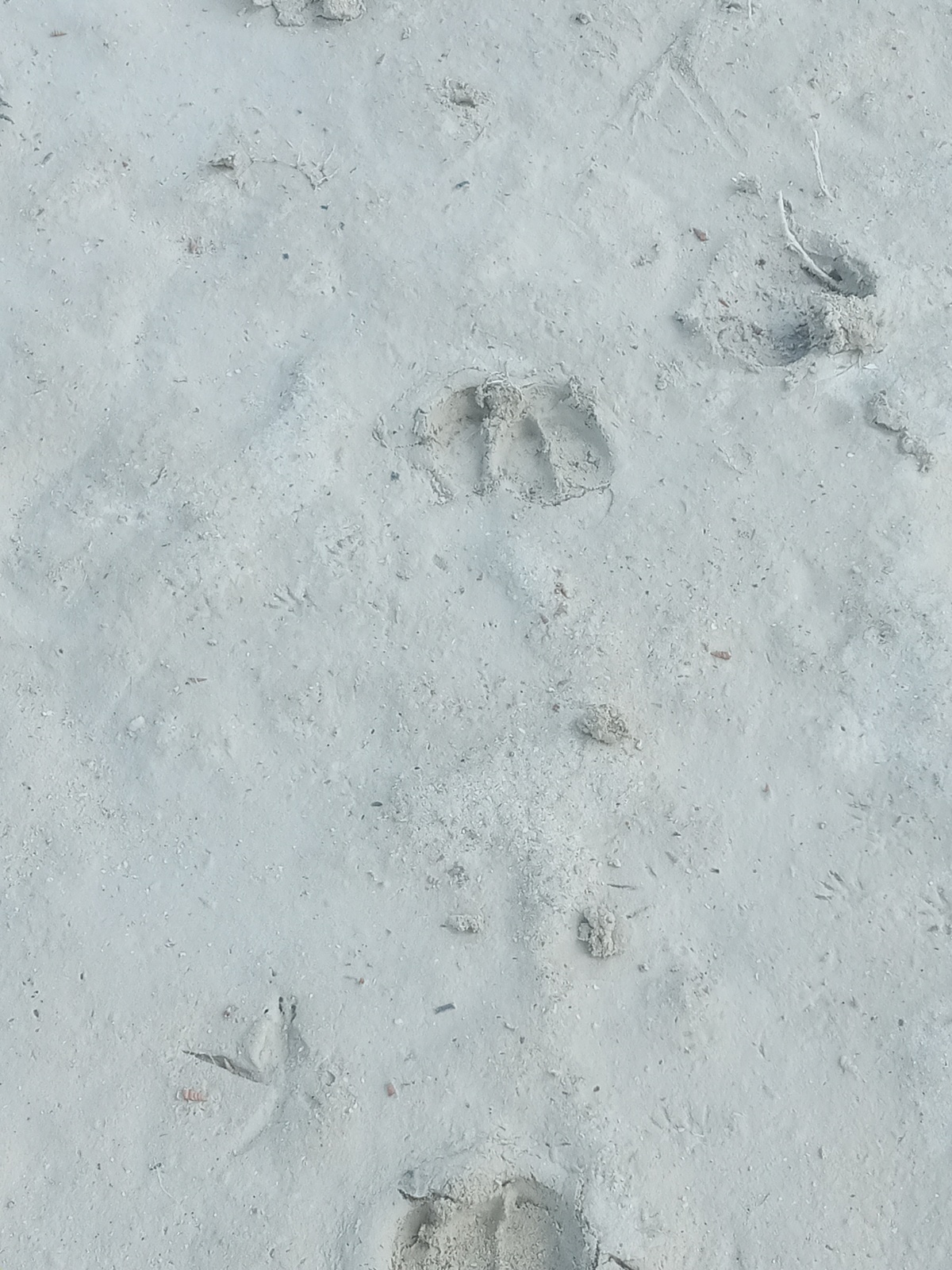Soaring with Science: A Collaborative Approach to Protect Inagua’s Flamingos
By: Elijah Sands
Photos By: Elijah Sands and BNT Science Dept.
May 26, 2023
In the serenity of Inagua, one of the world’s largest Caribbean flamingo populations is under threat by invasive feral hogs. Thanks to generous supporters from BNT’s 2022 Pig Roast and Morton Salt Bahamas, we’re able to tap into the future – employing cutting-edge technology, such as drones and motion sensor cameras, to defend our treasured flamingos.

There’s more to the flamingos of Inagua than their pretty pink feathers, interesting sounds and their odd, one-legged stance. There is an amazing conservation story behind these birds, in which the BNT played a key role in bringing them back from near-extinction to tens of thousands of birds on the island of Inagua today. Despite this success, their well-being on this island is under threat.
The story of the Caribbean Flamingo (also called American Flamingo), is one of the greatest conservation success stories of the 21st century. Historically, they were indiscriminately hunted for food, for feathers, and for fun. Feral hogs introduced by early settlers in The Bahamas also played a major role in the bird’s declining populations. Hogs frequently fed on the flamingo eggs and young, disturbing entire rookeries while doing so. Due to all these forces, flamingos practically disappeared from many places in The West Indies and even places like Florida.
By the 1950s, the National Audubon Society was active in The Bahamas and was searching for remaining colonies of flamingos. In Inagua, a small flock was discovered and this shined a new ray of hope for the future of the iconic bird. The Society for the Protection of the Flamingo in The Bahamas was formed and the National Audubon Society supported its work.
When The Bahamas National Trust was created in 1959, the organisation took over the work of the Society of the Protection of the Flamingo. The BNT hired local hunters, Samuel and Jimmy Nixon, as its first wardens and worked with the Audubon Society, the Bahamian Government, and partners like Morton Salt Bahamas to advance the conservation and protection of flamingos in Inagua. This included the creation of the Inagua National Park (INP) in 1965. Encompassing 287 square miles of vast, remote beauty and wilderness, the park protects an important part of Lake Rosa, where flamingos are known to nest.

Fast forward to recent times, flamingos now thrive on Inagua and have populated other islands in the archipelago. It is believed that Inagua Island and the Inagua National Park are home to one of the largest breeding colonies of Caribbean Flamingos on the planet. The BNT maintains an active presence on the island, and our wardens keep a sharp watch over our national bird.
However, in 2021, disaster struck. While on patrol, BNT wardens discovered an entire abandoned flamingo rookery. Thousands of egg mounds with eggs were left to bake in the harsh sun. Many of the eggs were broken, their contents hollowed out. It wasn’t long before we discovered the cause of the tragedy – hog tracks were scattered all throughout the mud. Without a doubt, a couple of hogs had found their way to the rookery, startling the birds and causing them to abandon their nests. This wasn’t the first time hogs had caused entire rookeries to be abandoned on the island, but this type of disturbance hadn’t been documented in years. Sadly, flamingos haven’t been observed nesting on Inagua since this incident.
After this discovery, it became very clear to the BNT that we needed to act immediately to prevent a recurrence of this situation. We started to devise a plan to control the feral hogs in Inagua. However, we faced one major issue: we knew very little about them.
“Our knowledge of the hogs was largely anecdotal, based on hunters’ accounts, wardens’ general observations, and other eyewitness accounts. And although we knew hogs were plentiful on the island, we lack quantitative data on their populations – densities, ranges, and habitat use for example – the kind of data needed to plan for their control. Consequently, our initial efforts have centred on developing a strategy to gather baseline information on hog populations on the island. This marked the inception of the Inagua National Park Invasive Species Management Program. This program intends to conserve the park’s biodiversity by making data-driven decisions to control invasive species.” — Falon Cartwright, BNT Director of Science and Policy
In February 2023, a team from the BNT, led by Executive Director Lakeshia Anderson Rolle, travelled to Inagua to meet with stakeholders, tour the Inagua National Park, and launch the Invasive Species Management Program. The team included members of the Trust’s Science Team, who had specific objectives to advance this program and would remain on the island after most of the group departed.
One of our very first stops was a courtesy call with our long-time partner in flamingo conservation, Morton Salt Bahamas Limited. Morton has supported the BNT and flamingo conservation for decades and had recently made a significant contribution towards the Invasive Species Management Program.
During a tour of the Inagua National Park on this trip, General Manager of Morton Bahamas Ltd, Mr. Jesus Rodriguez, accompanied us on the long, remote journey. Along the way, we were thrilled to spot several flocks of flamingos, including a courting flock, signifying the potential return of nesting. As expected, we also observed signs of invasive hogs throughout the park tour as we made our way to the historic Camp Vernay.
“The scenes from the abandoned rookery were discouraging – thousands of abandoned nest mounds and scattered animal tracks painted a forlorn picture”
Morton Salt’s expansive flat saltpans across Inagua serve as a buffet for the flamingos. Brine shrimp are usually present in the salt pans that Morton uses in their salt-production process. These shrimp, along with other microorganisms, form a major part of the flamingo’s diet. The flamingos naturally flock to the saltpans to feed, and in this way, Morton’s operations provide feeding habitat for the birds. Morton supports the BNT’s Inagua operations generally, by providing office space and maintaining vital access roads to the park. The BNT is grateful for Morton’s continued support and looks forward to a fruitful, sustained partnership.
“At Morton Salt, we are passionate about building a sustainable future for our company, the communities in which we operate, and the world around us. We bring this passion to life through a wide range of business, social, safety, quality, and environmental programs that are designed with future generations in mind. Morton Bahamas Limited is pleased to support the Bahamas National Trust Invasive Species Management Program in Inagua, which will aid in preserving the flamingos’ natural habitat and avert environmental harm. This is an important step in protecting the area’s distinctive biodiversity and the long-term viability of the flamingo population” — Jesus Rodriguez, General Manager of Morton Bahamas Ltd
Bringing Modern Technology to The Fight
“The BNT is grateful for Morton’s continued support of flamingo conservation and looks forward to a fruitful, sustained partnership.”

During this trip, we piloted two technologies to help us with monitoring efforts: drones and motion sensor cameras.
Taking conservation to new heights – quite literally – we are employing drone technology in our fight against invasive species. These unmanned aerial vehicles (UAVs) have graduated from the realms of science fiction and film to practical and powerful tools for wildlife conservation. Equipped with state-of-the-art cameras, these drones offer high-resolution aerial imagery and live video feeds, enabling us to explore vast and inaccessible landscapes from a bird’s-eye view – a task impossible with ground patrols alone. Advanced thermal imaging technology allows us to track warm-bodied organisms like hogs even under the cloak of night. In addition, these drones are excellent tools for surveying flamingo flocks and nesting grounds to estimate population sizes and breeding activity, without disturbing the birds.
As a training and reconnaissance exercise, the science team used the drones to capture updated aerial imagery of known historical nesting sites within the park. The team also located and documented the abandoned rookery that was impacted by hogs in 2021. No nesting was observed on these flights, or the entire trip. But, whenever wardens confirm nesting is taking place again, the science team will return to survey rookeries using the drones and count nests as well as the number of successful fledglings.
Science Staff and Park Wardens piloted the drone technology and tested out the drone’s features in the Inagua National Park

Alongside our airborne monitoring, we have deployed an army of motion-sensor cameras for ground surveillance. These are not your ordinary security cameras; they are advanced, weather-resistant devices specifically designed for wildlife monitoring. They use infrared sensors triggered by both motion and heat, ensuring they capture the presence of warm-bodied animals. The cameras provide 24/7 monitoring and invaluable insights into hog behaviour and movements. And the quality of the imagery even allows for the identification of individual animals, which will help us estimate the number of individuals or relative abundance in certain areas. Ultimately, the imagery and the data from these cameras will help us strategize where and how to focus our control efforts and tell us whether these efforts are effective in the long term.
By employing this technology, we are minimizing disruption to other wildlife and ensuring our methods are as strategic as possible. We remain committed to finding innovative ways and approaches for managing national parks and conserving the biodiversity of The Bahamas, including our beloved flamingos.
Inagua Park Wardens were trained to properly operate the new drones and motion sensor cameras. Long after the science team left the island, the wardens continue to utilise this technology in their monitoring efforts. One of the next major steps is to create updated high-quality habitat maps that also show the flamingo and hog activity documented, and use these to strategically deploy traps to begin capturing feral hogs.
The Way Forward
“It wasn’t long before we received the first images from our motion sensor cameras – verifying the presence of invasive species in certain areas.”

“While the battle against invasive species is a long and complex one, we’re confident that with technology as our ally, we can tip the scales in favour of the flamingos. While it is unrealistic to think we can completely rid the vast island of Inagua of wild hogs, by learning about their movements and being proactive in controlling their populations in the most critical areas, we’re taking a step towards a future where our children, and their children, can still marvel at the spectacle of a ‘pink sea of flamingos,’ safe and thriving in the wilds of Inagua.” — Lakeshia Anderson-Rolle, BNT Executive Director
“While the battle against invasive species is a long and complex one, we’re confident that with technology as our ally, we can tip the scales in favour of the flamingos.”
This monumental work is possible through the generous support of Morton Salt Bahamas, and the amazing supporters of the BNT’s 2022 Cuban Pig Roast event. The Pig Roast is one of BNT’s flagship fundraising events, raising critical funds every year for our priority conservation projects. In 2022, supporters at Pig Roast raised over $100k to support flamingo conservation in Inagua. These funds are being channelled to support the activities of the Inagua National Park Invasive Species Management Program.
If you would like to support the Inagua Invasive Species Management Program, you can click here to make a donation today.
—-
Elijah Sands is the Senior Communications Officer at The Bahamas National Trust and documents BNT conservation initiatives and biodiversity within national parks around The Bahamas.















![P00[849:840] TT[7365] E[185:0023]G[000:0x00] BV[152:0] IR[X:F:34]](https://bnt.bs/storage/2023/05/IMG_1440.jpg)


![P00[0:0] TT[801] E[070:3409]G[288:0x5a] BV[-30:-5] IR[X:L:9]](https://bnt.bs/storage/2023/05/Camera-1_20230303-4.jpg)
